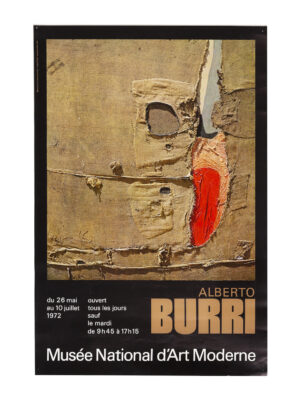Alberto Burri is an Italian painter, among the most important of the 20th century. He anticipated movements such as arte povera and new realism with his technique, through the use of new and avant-garde materials such as tars, iron, molds, wood, earth and glue to create his material paintings.
His works are an example of informal art, a movement born in the late 1940s that rejected figurative and abstract art in favor of a new communication of matter.
The artist studied medicine and only decided to focus on art during a period of imprisonment in Texas during World War II. Once free, Burri arrived in Naples in 1946 and later moved to Rome, where he had his first solo exhibition at La Margherita gallery in 1947.
The following years saw the beginning of Burri’s experimentation with new and avant-garde materials, in which the material takes over the painting itself.
It is 1949 Assemblage SZ1, the first of Alberto Burri’s Sacchi, and in that year he also began working on tars. In 1950 he began experimenting with molds, humpbacks and sacks.
In 1951 he founded with Mario Ballocco, Giuseppe Capogrossi and Ettore Colla the group Origine, which was created to go beyond figurative art and abstractionism through the use of elementary forms and intense, violent colors.
It was the following year that decreed the painter’s international success, with his first exhibition in America in 1953 between Chicago and New York, Alberto Burri: paintings and collages. In 1955 a monograph at the Guggenheim and an exhibition at MOMA in New York were dedicated to him, and in the same year the artist exhibited at the Brazil Biennale and the Quadriennale in Rome.
In the late 1950s and early 1960s Burri intensified his exhibition activities and began experimenting with new materials. In 1957 he began to use the technique of welding on the first irons, and in 1962 he exhibited his first works made of plastic, materials on which he would work throughout the decade.
In 1964 he won the Marzotto prize for painting, and in the early 1970s he began Alberto Burri’s work on the Cretto.
In 1973 he made the first exhibition on the Cretto cycle, and in 1976 he created the Great Black Cretto, exhibited at the University of Los Angeles.
In 1979 he began the process of creating the Cycles, monumental works preserved in the Burri Museum of the Ex Seccatoi del Tabacco in the City of Castello. Over 120 paintings made between 1974 and 1993 are preserved here.
Also in Città di Castello in 1981 the Fondazione Burri, based in the Palazzo Albizzini, was inaugurated at the artist’s behest.
In 1984 Alberto Burri in Gibellina created his best known work: the Grande Cretto.






























